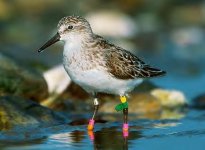Here’s my tuppence worth…….(which I’ve written before in this forum). I’m against this constant ringing that achieves little new. A lot of bird marking/ringing is not scientifically valid and at times, there is no doubt, is carried out solely for self- gratification. I’m not convinced either that the birds welfare comes first with some ringers.
Don’t forget that ‘marking’ birds at observatories/nature reserves etc includes dyeing, wing-tags, nasal saddles, attaching/taping transmitters, using canon netting – these, and more, all under that catch-all phrase of scientific study.
I've witnessed a tired vagrant (Bonelli's Warbler) in the hand lose all its tail feathers - what hope for that one's onward migration? And seen a White's Thrush hit the net and feathers just came out everywhere. Another, what point in ringing the vagrant Sora last year at Gibraltar Point when we know the outcome of the bird is to die, reorientate, head south, get killed by a cat etc…..what scientific value here?
Where it can be proven that we learn from ringing then fine, but are we to learn anymore from, say, Reed Warblers - the measurements/weights/migration routes are so well documented....what else to learn from any individual bird now? That's my point.....why do this at all if it serves no useful purpose (cf. Sora)....and which indeed must stress or harm individual birds. (I can provide studies on stress and heart rhythms when birds are simply being approached - for example, one study with White Terns whose heart rates soared, so they must suffer in the hand)
Here’s the pics that were used before. Can this Semi-p not be affected by the amount of rings here? And what about these awful nasal saddles used when rings cannot be seen? (Only trouble is that these birds get caught in vegetation, saddle gets iced over, damage to nares etc) Before you ask they are legal throughout the EU – I have seen a Teal with a saddle in the UK, which apparently was traced to the Camargue, France.





